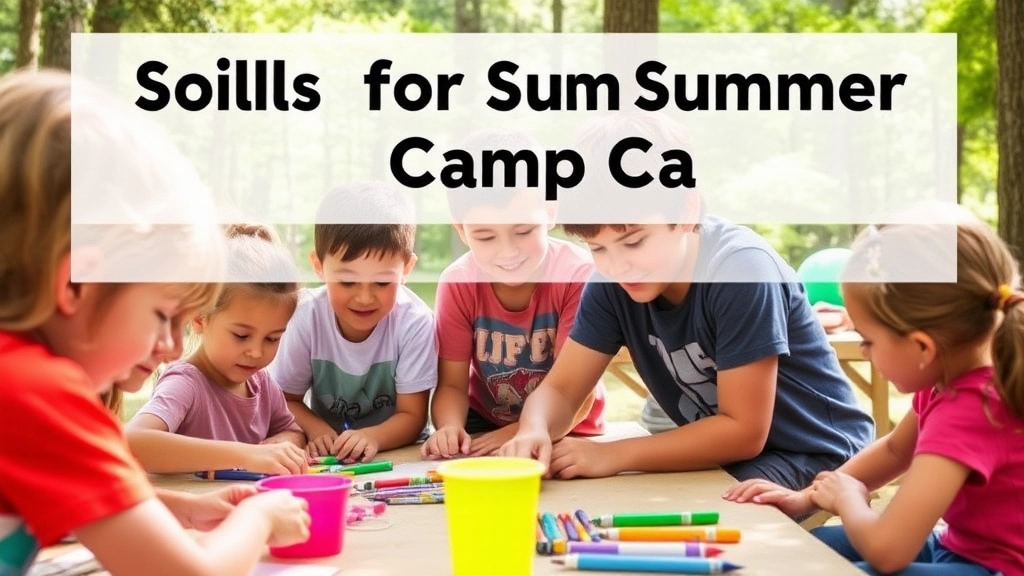Skills For Summer Camp
Welcome to a comprehensive exploration of essential Skills For Summer Camp. In this article, we’ll delve into the vital abilities that transform a simple camp experience into an unforgettable journey. From leadership to adaptability, these skills are not just beneficial but crucial for success.
We’ll cover everything from effective communication and team-building to outdoor survival and first aid. Whether you’re planning activities or resolving conflicts, these insights will equip you to handle any challenge. Let’s embark on this journey to enhance your summer camp experience with inclusivity and creativity.
Essential Leadership Skills
Ever felt like you’re just not cut out for leadership? Maybe you’ve been thrown into a role where you have to lead a team, and you’re worried you’ll mess it up. Trust me, we’ve all been there. Leadership isn’t about being the loudest or the smartest person in the room. It’s about having the right skills to guide your team to success. Let’s break it down.
What Makes a Good Leader?
Communication
First off, communication is key. If you can’t clearly express your vision and expectations, how can you expect your team to follow? Here’s how you can improve:
- Be Clear and Concise: Don’t ramble. Get to the point.
- Active Listening: Pay attention to what your team is saying. Sometimes, the best ideas come from the quietest voices.
- Feedback Loop: Regularly ask for and provide feedback. It keeps everyone on the same page.
Decision-Making
Next up, decision-making. You can’t sit on the fence forever. Here’s the deal:
- Gather Information: Make sure you have all the facts before making a call.
- Weigh the Pros and Cons: Simple, but effective.
- Be Decisive: Once you’ve made up your mind, stick to it. Wavering can erode trust.
Emotional Intelligence
Then there’s emotional intelligence. This isn’t just a buzzword. It’s about understanding your own emotions and those of others. Here’s how you can work on it:
- Self-Awareness: Know your strengths and weaknesses.
- Empathy: Put yourself in others’ shoes. Understand their feelings and perspectives.
- Manage Stress: Keep your cool, even when things get heated.
Leading by Example
Integrity
Integrity is non-negotiable. If you want your team to be honest and ethical, you have to lead by example. Simple as that.
Accountability
Own your mistakes. If you mess up, admit it. This builds trust and sets a precedent for your team to do the same.
Building Trust
Transparency
Be open about your decisions and the reasoning behind them. This doesn’t mean you have to share every little detail, but keep your team in the loop.
Consistency
Stick to your word. If you say you’re going to do something, do it. Consistency builds reliability.
Stories and Examples
Let me share a quick story. I once worked with a leader who never listened. He thought he knew it all. Guess what? He didn’t. The team was frustrated, and productivity tanked. When a new leader came in who actually listened and valued our input, things turned around almost overnight. The difference was night and day.
For more insights on leadership and building team cohesion, explore our ultimate guide to summer camp planning, which offers valuable tips on effective team management. Additionally, if you’re working with younger team members, check out our comprehensive guide on summer camps for troubled teens to understand different approaches to leadership and mentorship.
Effective Communication Techniques

Ever feel like you’re talking, but no one’s really listening?
Yeah, we’ve all been there.
Effective communication isn’t just about talking; it’s about connecting.
Why does communication matter?
Think about it.
Without good communication, your team can’t function.
Projects fall apart.
Misunderstandings happen.
Let’s dive into some techniques that can help you communicate like a pro.
Active Listening
First up, active listening.
This isn’t just nodding your head.
It’s about really listening.
- Make eye contact: Shows you’re engaged.
- Nod and respond: Simple “yes” or “I see” works wonders.
- Ask questions: Clarify and show interest.
Clear and Concise Messaging
Next, clear and concise messaging.
No one likes a rambler.
Keep it short and sweet.
- Use simple words: Ditch the jargon.
- Get to the point: What’s the main message?
- Check for understanding: Ask if they got it.
Non-Verbal Cues
Don’t underestimate non-verbal cues.
Your body language speaks volumes.
- Stand tall: Confidence, baby.
- Smile: It’s contagious.
- Watch your tone: Match it to your message.
Open-Ended Questions
Use open-ended questions to get the conversation flowing.
Instead of “Did you get that?”
Try “What are your thoughts on this?”
Feedback Loop
Create a feedback loop.
Communication is a two-way street.
- Give constructive feedback: Be specific.
- Receive feedback gracefully: Don’t get defensive.
- Act on it: Show you’re listening.
Storytelling
And let’s not forget storytelling.
People remember stories, not data.
- Share personal experiences: Makes you relatable.
- Use analogies: Simplifies complex ideas.
- Be authentic: Keep it real.
Digital Communication
In today’s world, digital communication is key.
Emails, chats, and video calls are the norm.
- Be clear and concise: No one reads long emails.
- Use emojis wisely: They can convey tone.
- Double-check before sending: Avoid misunderstandings.
Empathy
Finally, empathy.
Put yourself in their shoes.
- Acknowledge feelings: “I understand how you feel.”
- Show concern: “How can I help?”
- Be patient: Everyone processes differently.
So, there you have it.
Effective communication techniques that actually work.
Start practising these today.
And watch your connections improve.
Because good communication isn’t just a skill.
It’s a game-changer.
Team-Building and Collaboration
Ever wondered how to transform a group of individuals into a cohesive, high-performing team? Team-building and collaboration aren’t just corporate buzzwords; they’re the backbone of any successful group effort. Whether you’re leading a project at work or organising a community event, knowing how to foster teamwork is crucial. Let’s break it down.
Why Team-Building Matters
Team-building is all about creating a sense of unity and purpose. Without it, you’ll end up with a bunch of people working in silos, leading to miscommunication and inefficiency. Here’s why it’s essential:
- Boosts Morale: When people feel part of a team, they’re happier and more productive.
- Enhances Communication: Open lines of communication mean fewer misunderstandings.
- Improves Problem-Solving: Diverse teams bring different perspectives, leading to better solutions.
- Builds Trust: Trust is the foundation of any successful team. Without it, collaboration falls apart.
Key Elements of Effective Team-Building
So, how do you actually build a team that works well together? Here are some practical tips:
- Set Clear Goals: Everyone needs to know what they’re working towards. Clear, achievable goals keep everyone on the same page.
- Define Roles and Responsibilities: Make sure everyone knows their role and what’s expected of them.
- Foster Open Communication: Encourage team members to speak up and share their ideas. This can be done through regular meetings or even casual check-ins.
- Encourage Collaboration: Use collaborative tools and techniques to make it easy for team members to work together. Think shared documents, project management software, and brainstorming sessions.
- Celebrate Successes: Don’t just focus on what’s not working. Celebrate the wins, no matter how small. This boosts morale and keeps the team motivated.
Practical Team-Building Activities
Now, let’s talk about some activities that can help build team cohesion. These aren’t just for fun; they serve a real purpose in strengthening your team.
- Icebreakers: Simple activities like âTwo Truths and a Lieâ can help team members get to know each other.
- Problem-Solving Challenges: Activities like escape rooms or puzzle challenges can improve teamwork and communication.
- Team Retreats: Taking the team out of the usual environment can help them bond and recharge.
- Workshops: Skill-building workshops not only improve individual capabilities but also foster a sense of shared learning.
Real-Life Example
I remember working on a project with a team that was all over the place. We had the skills but lacked cohesion. So, we decided to spend a day doing team-building activities. We did a mix of icebreakers and problem-solving challenges. By the end of the day, we knew each other’s strengths and weaknesses much better. This made it easier to collaborate and communicate effectively, and the project was a success.
Common Challenges and How to Overcome Them
Even the best teams face challenges. Here are some common issues and how to tackle them:
Outdoor Survival Skills

Ever wondered what you’d do if you got lost in the wild?
Yeah, me too.
Outdoor survival skills aren’t just for adventurers; they’re for anyone who steps outside.
So, let’s break it down.
Why You Need Survival Skills
Look, nature’s unpredictable.
Weather changes.
You might get lost.
Or maybe your gear fails.
Having basic survival skills can be a lifesaver.
Key Skills to Master
- Finding Water:
- Streams, rivers, and lakes are obvious.
- But what if they’re dry?
- Learn to collect dew or use a solar still.
- Building Shelter:
- Keeps you warm.
- Protects you from the elements.
- Use natural materials like branches and leaves.
- Starting a Fire:
- Essential for warmth and cooking.
- Learn different methods:
- Flint and steel
- Fire plough
- Bow drill
- Navigating Without a Compass:
- Use the sun, stars, and natural landmarks.
- Understand how to read a topographic map.
- Identifying Edible Plants:
- Know which plants are safe to eat.
- Avoid anything you’re unsure about.
Real-Life Examples
Remember that guy who got lost in the Rockies?
He survived because he knew how to find water and build shelter.
Or the woman who navigated her way out of a dense forest using the stars.
These skills work.
Quick Tips for Beginners
- Practice Makes Perfect:
- Don’t wait until you’re in a jam.
- Practice these skills regularly.
- Stay Calm:
- Panic clouds judgment.
- Take deep breaths and think clearly.
- Pack the Essentials:
- Always carry a survival kit.
- Include items like a knife, fire starter, and a whistle.
Creative Problem-Solving
Ever found yourself stuck in a rut, scratching your head, and wondering how to get out of a tricky situation? Creative problem-solving is the secret sauce that can turn a seemingly impossible challenge into a walk in the park. Let’s dive into how you can master this essential skill.
Why Creative Problem-Solving Matters
Here’s the deal: Problems are inevitable. Whether you’re leading a team, planning an activity, or just trying to survive a day in the wild, you’ll face obstacles. The ability to think outside the box and come up with innovative solutions is what separates the good from the great.
Steps to Boost Your Creative Problem-Solving Skills
1. Identify the Problem Clearly
- Ask Questions: What exactly is the problem? Why is it a problem? Who does it affect?
- Break it Down: Split the issue into smaller, manageable parts. This makes it less daunting.
2. Brainstorm Solutions
- Go Wild with Ideas: No idea is too crazy. The more, the merrier.
- Involve Your Team: Two heads are better than one. Involve others to get diverse perspectives.
3. Evaluate and Choose the Best Solution
- Pros and Cons: List the advantages and disadvantages of each idea.
- Feasibility Check: Can you realistically implement this solution? Do you have the resources?
4. Implement the Solution
- Action Plan: Create a step-by-step plan to bring your solution to life.
- Assign Roles: Make sure everyone knows their part in the plan.
5. Review and Reflect
- Did it Work?: Evaluate the outcome. Did your solution solve the problem?
- Learn and Adapt: Reflect on what worked and what didn’t. Use this knowledge for future problems.
Real-Life Example: Turning a Mess into Success
Imagine you’re in the middle of a team-building exercise, and suddenly, it starts pouring rain. The original plan was to have an outdoor activity, but now everyone’s drenched and miserable. What do you do?
- Identify the Problem: The outdoor activity can’t continue due to the rain.
- Brainstorm Solutions: Move the activity indoors, switch to a different game, or use the rain to your advantage and have a fun, impromptu rain dance.
- Evaluate and Choose: Moving indoors seems the most practical.
- Implement: Quickly set up an indoor space for the activity.
- Review: Did everyone enjoy the indoor activity? What could be improved next time?
Tips for Enhancing Creative Problem-Solving
- Stay Curious: Always ask questions and seek new information.
- Embrace Failure: See failures as learning opportunities.
- Keep an Open Mind: Be willing to consider unconventional ideas.
- Practice Regularly: The more you practice, the better you’ll get.
For more tips on engaging activities, check out our Top Summer Camp Games and Activities Guide. If you’re looking for creative ways to keep kids entertained, our Fun Summer Camp Crafts for Kids article is a must-read!
Conflict Resolution Strategies

Ever had a situation where two team members just can’t see eye to eye?
Yeah, me too.
Conflict happens, but how you handle it can make or break your team’s dynamic.
Let’s dive into some conflict resolution strategies that actually work.
Why Conflict Happens
First, why does conflict happen?
- Different perspectives: People see things differently.
- Miscommunication: Messages get lost or misinterpreted.
- Stress: High-pressure situations bring out the worst in us.
Steps to Resolve Conflict
So, how do we tackle these issues head-on?
-
Identify the Root Cause
- Sit down with the parties involved.
- Ask open-ended questions to get to the real issue.
-
Active Listening
- Nod, make eye contact, and paraphrase what’s being said.
- Show that you genuinely care about their feelings and viewpoints.
-
Stay Neutral
- Don’t take sides.
- Your job is to mediate, not to judge.
-
Find Common Ground
- Look for shared goals or values.
- Focus on what unites rather than what divides.
-
Brainstorm Solutions
- Encourage both parties to suggest solutions.
- List out all possible options without criticism.
-
Agree on a Plan
- Choose a solution that works for everyone.
- Set clear steps and deadlines to implement the plan.
Real-Life Example
I once had two team members who couldn’t agree on a project direction.
We sat down, identified the root of their disagreement, and found out it was all about miscommunication.
By actively listening and staying neutral, we found common ground and brainstormed a solution that satisfied both parties.
Conflict resolved.
Keep It Real
Remember, conflict resolution isn’t a one-size-fits-all.
You’ve got to adapt these strategies to fit your team’s unique dynamics.
But trust me, these steps are a solid start.
First Aid and Safety Knowledge
Let’s face it, when you’re out in the wild or even just leading a team, First Aid and Safety Knowledge isn’t just a nice-to-haveâit’s a must-have. Imagine you’re on a hike, and someone twists an ankle or gets stung by a bee. What do you do? Panic? Nope. You need to know how to handle it right then and there. So, let’s dive into the essentials.
Why First Aid and Safety Matter
First off, why should you care about first aid and safety? Well, here are some real questions and worries that might keep you up at night:
- What if someone has an allergic reaction?
- How do you handle a broken bone in the middle of nowhere?
- What if there’s a fire?
These aren’t just hypothetical scenarios. They’re real-life situations that can happen anytime, anywhere. Knowing First Aid and Safety Knowledge can make the difference between a minor hiccup and a major disaster.
Basic First Aid Skills Everyone Should Know
Alright, let’s break it down. Here are the basic first aid skills you need to master:
- CPR (Cardiopulmonary Resuscitation): This could save a life. Learn how to perform chest compressions and rescue breaths.
- Wound Care: Know how to clean and dress a wound to prevent infection.
- Burn Treatment: Learn the steps to cool and cover burns to minimise damage.
- Choking: Understand the Heimlich manoeuvre to save someone from choking.
- Allergic Reactions: Be able to identify symptoms and know how to use an EpiPen.
Safety Knowledge: More Than Just First Aid
Safety isn’t just about bandages and CPR. It’s about preventing accidents before they happen. Here’s what you need to keep in mind:
- Risk Assessment: Always evaluate the environment for potential hazards.
- Emergency Plans: Have a clear plan for what to do in various emergency scenarios.
- Fire Safety: Know how to use a fire extinguisher and have an evacuation plan.
- Hydration and Nutrition: Keep everyone well-fed and hydrated to prevent issues like heatstroke or hypothermia.
Real-Life Examples
Let’s sprinkle in a couple of stories to keep it real. I remember a time when I was leading a group on a camping trip. One of the kids got a nasty cut while whittling. Thanks to my first aid training, I was able to clean and dress the wound quickly, avoiding any serious complications. Another time, during a team-building exercise, someone fainted due to dehydration. Knowing how to handle it and having a plan in place made all the difference.
Internal Linking Opportunities
If you’re serious about leadership, you’ll also want to check out our sections on volunteer benefits and tips and federal grants for summer camps. These skills go hand-in-hand with first aid and safety, making you a well-rounded leader.
Activity Planning and Organization

Ever tried to plan an activity and felt like you were herding cats?
Yeah, me too.
Activity planning can be a real headache.
But it doesn’t have to be.
Here’s how to nail it.
Why Planning Matters
Planning isn’t just about jotting down a few ideas.
It’s about creating a roadmap.
Without it, you’re lost.
And so is your team.
Steps to Effective Planning
- Define Your Goals: What do you want to achieve?
- Fun?
- Learning?
- Team bonding?
- Know Your Audience: Who are you planning for?
- Kids?
- Adults?
- Mixed group?
- Set a Timeline: When is the activity happening?
- Today?
- Next week?
- Next month?
- Resources and Budget: What do you need?
- Materials?
- Money?
- People?
Breaking It Down
Create a Checklist:
- Venue booked?
- Supplies ordered?
- Team briefed?
Delegate Tasks:
- Assign roles.
- Make everyone accountable.
Prepare for the Unexpected:
- Have a Plan B.
- Flexibility is key.
Real-Life Example
Remember that time we planned a team-building day in the park?
We had everything set.
Then it rained.
Hard.
But because we had a backup plan, we moved indoors and still had a blast.
Tools to Help You Plan
- Trello: For task management.
- Google Calendar: For scheduling.
- Slack: For communication.
Keep It Fresh
Don’t just repeat the same activities.
Mix it up.
Try new things.
Keep everyone engaged.
Adaptability and Flexibility
Ever felt like you’re juggling too many balls in the air? Trust me, I get it. Life can throw curveballs, and the ability to adapt and stay flexible is crucial. Adaptability and flexibility aren’t just fancy buzzwords; they’re essential skills that can make or break your success, whether you’re leading a team, surviving in the wild, or simply navigating everyday life.
Why Adaptability and Flexibility Matter
Adaptability and flexibility are about being open to change and ready to pivot when necessary. They help you:
- Handle unexpected challenges: Life is unpredictable. Being adaptable means you’re prepared to tackle whatever comes your way.
- Stay relevant: In a fast-paced world, those who adapt quickly are the ones who thrive.
- Improve problem-solving: Flexible thinking allows you to see solutions from different angles.
Real-Life Examples
Let’s break this down with some real stories. Imagine you’re leading a team on a project with a tight deadline. Suddenly, a key member falls ill. Do you panic? No. You adapt by reassigning tasks and maybe even taking on some extra work yourself. This isn’t just about being a good leader; it’s about keeping the project on track.
Or picture this: you’re on a camping trip, and the weather takes a turn for the worse. Instead of sticking to your original plan, you adapt by finding a sheltered spot and setting up camp there. Your ability to stay flexible keeps everyone safe and dry.
Tips for Building Adaptability and Flexibility
Want to become more adaptable and flexible? Here are some tips:
- Embrace change: Instead of resisting change, see it as an opportunity to grow.
- Stay curious: Always be willing to learn new things. The more you know, the easier it is to adapt.
- Practice resilience: Bounce back from setbacks quickly. This builds your mental toughness.
- Be open-minded: Listen to others’ ideas and perspectives. They might offer solutions you hadn’t considered.
Practical Exercises
Here are a few exercises to help you develop these skills:
- Scenario planning: Think about potential challenges you might face and how you’d handle them.
- Role-playing: Practice different roles within your team to understand various perspectives.
- Mindfulness meditation: This helps you stay calm and focused, making it easier to adapt to changes.
Final Thoughts
Adaptability and flexibility are like muscles; the more you use them, the stronger they get. They help you stay ahead of the game, no matter what life throws at you. So, next time you’re faced with a challenge, remember: it’s not about the situation; it’s about how you handle it. For more insights, check out our guide on the benefits of summer camps.
Encouraging Inclusivity and Diversity
Ever feel like your team isn’t as inclusive as it could be?
Or maybe you’re worried about missing out on diverse perspectives?
Inclusivity and diversity aren’t just buzzwordsâthey’re game-changers.
Why It Matters
When everyone feels included, the magic happens.
Diverse teams bring fresh ideas and different viewpoints.
This isn’t just about being nice; it’s about innovation and growth.
How Do We Encourage It?
Here’s what works for me:
- Listen Actively: People want to feel heard. Make it a habit to listen more than you speak.
- Create Safe Spaces: Encourage open dialogue where everyone can share without fear.
- Celebrate Differences: Highlight and celebrate cultural events and unique backgrounds.
- Educate Yourself and Others: Keep learning about different cultures and perspectives. Share what you learn.
Real Talk
I once worked with a team that was stuck in a rut.
We realised we were all too similar.
By bringing in diverse voices, we turned things around.
Quick Wins
- Diverse Hiring: Look for talent in different places.
- Inclusive Policies: Ensure your policies support all team members.
- Mentorship Programs: Pair up people from different backgrounds to learn from each other.
Keep It Going
Inclusivity isn’t a one-time thing.
It’s an ongoing journey.
Stay committed, keep learning, and watch your team thrive. For more ideas on fostering a collaborative environment, check out our essential guidelines for safety and top features of summer camp buildings.
FAQs: Skills For Summer Camp
What are some effective communication techniques for summer camp?
Effective communication techniques include active listening, clear and concise messaging, understanding non-verbal cues, using open-ended questions, creating a feedback loop, and employing storytelling and digital communication strategies. Also, practicing empathy is crucial.
Why is active listening important?
Active listening ensures that you are truly engaging with the speaker. This involves making eye contact, nodding, responding appropriately, and asking questions to clarify and show interest.
What are the essential outdoor survival skills for summer camp?
Key outdoor survival skills include finding water, building shelter, starting a fire, navigating without a compass, and identifying edible plants. These skills are critical for handling unpredictable situations in nature.
How can I effectively resolve conflicts at summer camp?
Effective conflict resolution involves identifying the root cause, practicing active listening, staying neutral, finding common ground, brainstorming solutions, and agreeing on a plan. These steps can help maintain a harmonious environment.
What are some key steps for effective activity planning and organization?
Effective activity planning involves defining your goals, knowing your audience, setting a timeline, and considering resources and budget. Additionally, creating a checklist, delegating tasks, and preparing for unexpected events are crucial steps.
Why is it important to have a backup plan for activities?
Having a backup plan ensures that activities can continue smoothly even if unexpected issues arise, such as bad weather. Flexibility and preparation are key to successful activity planning.
How can I keep activities fresh and engaging at summer camp?
To keep activities fresh and engaging, avoid repeating the same activities. Mix things up and try new ideas to maintain excitement and interest among participants.
References
-
Effective Communication Techniques – MindTools
-
Outdoor Survival Skills – REI Expert Advice
-
Conflict Resolution Strategies – Harvard PON

